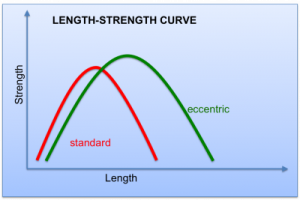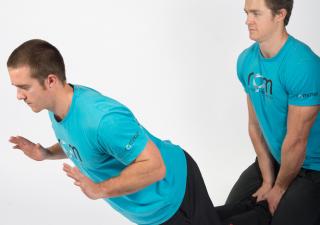We want to increase strength. No surprises there. And yet we fail to use eccentric training as a mainstay of our programming. So what is eccentric training, and how can we use it to maximise performance.
Eccentric training involves training the ‘lowering’ phase of a movement. The average person can lower 40% more weight than they can lift (and still control it). So if you can lift 100kg off the ground (deadlift), you can lower 140kg from this top position back to the floor.
Let’s examine the effect this eccentric training has.
The following graph shows the strength of a muscle trained eccentrically (green), and one trained using standard methods (red), at different muscle fibre lengths. What this tells us, is that we are able to generate more force after eccentric training, and we are able to generate it over a greater variance in muscle lengths. Effectively, what this does is to make us stronger over a greater range of motion, increasing our muscles’ torque generating ability. Therefore, less sticking points, less failures on heavy lifts.

So how do we train eccentrically? Simply focus on the lowering phase of lifts. For example:
- Set the pins on a squat rack so the barbell is at the top of your deadlift and load it up with 40% more than your max deadlift. Unrack it and lower slowly with good technique.
- Load up the squat bar with 40% more than your max squat. Lower slowly, then have a spotter(s) assist you on the way back up.
- Load up an overhead press with 40% more than your strict press. Jerk it overhead, then lower it slowly.
The same thing can be completed for almost all the ‘slow’ lifts (non-olympic) and most bodyweight (add weight) exercises.
Try adding these into your supplemental strength training and watch your strength numbers go through the roof.





